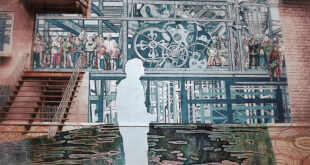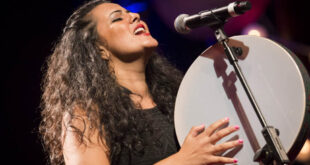This paper was presented at the Broadcast Education Association's annual convention in April 2004, where the author participated in a panel organized by the association's International Division.
The dark desert night is alight with streaks of blue and red streaming across the sky. A mosque is the symbol-laden backdrop for a news reporter who tells the viewer that yet another bomb has been dropped on Baghdad in this continuous barrage of explosive heavy metal. We see none of the damage. We are hearing a visual story told by a reporter confined to a roof and whose access to the real facts--what exactly is being bombed, who exactly are being killed-is barely better than ours, watching hundreds or thousands of miles away. The significance of the bombing-a massacre of civilians or extraordinary precision bombing of various Baathist command headquarters--is assumed by the viewer's own perspective and the reporter's assumptions. He really doesn't know.
The Mexican War (1846-1848) was the first American war to be photographed. The daguerreotype photo process was inconvenient and didn't allow photographs on the battlefield. A slain soldier's grave often replaced images of those killed and wounded on the field of battle.
Battlefield dead were initially viewed in the Civil War. The photographic process made it virtually impossible to obtain action photos, so photographers captured images between the end of battle and burial. Deceptive techniques used to manipulate the mind of the viewer were applied even then. Alexander Gardner used camera angles and varied captions so he could repeat the same photos of battlefield corpses to represent both Union and Confederate victims.
The photographs were both alluring and repellent to the stunned American viewer, who knew more about the Civil War than the war in Iraq. Until the brutal and horrible images from Fallujah were published, even photos of body bags and aluminum caskets wrapped in American flags were banned by the Bush administration.
The Americans are at war, not with a country but with a person (not allowed constitutionally, but since 9/11 everything goes) and the psychological impact of visual images on the viewers, and their manipulation through television and print, is dropped off right in their homes.
George Orwell wrote in his classic 1984 that "Big Brother is watching us." Not only is this true but with the introduction of the video camera as a photo journalism tool, by 1984 Big Brother no longer needed to watch us, for we were watching him. This is most evident in the media coverage of events after 9/11. Let us examine some of the images that have influenced both the Middle East and the West.
If "one picture is worth a thousand words," then the repetition of that picture one thousand times would etch that image into the mind and heart of any viewer. CNN's continuous showing of the hijacked airplane crashing into the World Trade Center in New York City has ingrained that image and all its various implications into the minds of the entire world. Visuals are powerful.
Along with the image itself CNN invented public relations and advertising language to persuade its audience that the United States was in a War on Terrorism, that good was battling evil, and that this was a new kind of war. The typography on the screen was wrapped in colors of the American flag. There was nothing subliminal about the images or the typography, which in itself is an image. Here was a new tune to rally around the flag, boys.
Think of the language typographically displayed on the screen.
More than a decade before, that language-"Desert Shield," "Desert Storm"-was an indication that war fought in a desert, void of humanity as we know it, cannot harm our soldiers.
Immaculate images and censored reporting by "embedded" journalists, along for the government ride, not unhindered reporting, influenced the viewer in his living room and indicated that all was going well. Censorship was imposed in the name of security of position and images are just not there for us to see.
Journalists know that you can make a small crowd look large by showing close-ups and extreme close-ups. This was the method used to influence the viewer by showing sixteen Palestinians dancing in the streets after 9/11: it appeared to the unknowing viewer that all of Palestine and perhaps the entire Middle East was dancing joyfully to the tune of their pain-a psychologically shocking image.
Viewed close-up with no perspective, it appeared to the viewer as if the entire city of Kabul was bombed. In fact Kabul was already a shelled-out city due to its war with Russia and civil strife.
Al Jazeera showed the romantic Osama Bin Laden riding horseback, delivering calm messages to an unseen audience, and holding weapons to "ward off anyone who was against Islam."
The print image from Life or Look magazine which influenced a mere million or two million people, every week or two, has been replaced by the "global image," one that influences the entire world instantaneously.
In 1928 there were two million radio sets in Great Britain. Today, America has almost 100 million television sets in use for an average of 7 hours each day. These 100 million television sets display channels that are dedicated to music, comedy, drama, shopping, and news.
No other time in history has allowed so many people to be reached, influenced, and psychologically manipulated as the present. We have invited the weapons of mass distraction into our homes.
News is inexpensive programming. We are given the feeling that there is no time left with programs aptly named 20/20, 60 minutes, and 48 hours. Just as we do everything in life that is urgent and little that is important, we are influenced to believe that what is selected to be shown on our screens is indeed fact. Like the product ad that reads "as seen on television."
So big was the 9/11 story that the networks temporarily set aside their pursuit of profit and allowed us to see the singular devastation time and again. What would TV have done with Dresden, where over 25,000 mostly innocent people were killed by bombs in one night?
Not everyone has a television set in the Middle East, but many do, and those who do not can watch at the local ahwa, or coffee shop, which constantly displays sports events and news.
In Cairo public demonstrations are allowed only with government permission. Thus they are contained and at times the hard plastic helmeted, shield and stick wielding police way outnumber the demonstrators. A crowd of just a few hundred in Cairo can be made to look like thousands by CNN. The western mind is thus fuelled to defend itself from these mad, shouting supporters that the media has labeled "Islamic terrorists." Of course any twelve year-old rock- throwing Palestinian child is media labeled as a dangerous enemy worthy of potentially lethal rubber coated bullets, while an Israeli who enters a mosque and massacres (by shooting in the back) some forty praying Muslims is an extremist, not a terrorist.
The continuous display on television of "images of empathy," where not only the image is important but who is watching is as important, proves that a shared cultural experience can be viewed as oppression by one viewer and dissention by another.
Stalin said, "The death of one person is a tragedy, and the death of a million people is a statistic."
All opinions influence and an image is an opinion. The same images that stirred Americans might, when seen by others, unleash ideological preconceptions with different points of view, whether they are in France, Saudi Arabia, or Asia.
Conversely, in Iraq, images provided by embedded TV journalists had the same narrowing perspective. A sanitized war of high adventure and low casualties that suggested little to that grim future that we now endure-a troubled, violent, occupied Iraq.
Each war has engraved a lasting image.
* Mathew Brady's photograph of several dead Confederate soldiers in a field following the battle at Antietam.
* Joe Rosenthal's World War II photograph of the planting of the American Flag at Iwo Jima. A set-up shot.
* Robert Capa's dying soldier.
* The naked, crying napalmed Vietnamese girl.
* Eddie Adams' photograph of the Vietnamese general shooting his enemy point blank in the head.
* The Palestinian boy Mohammed al Durra caught in crossfire with his father.
* And the falling statue of Saddam Hussein in Iraq.
These were tame images next to the flesh peeling from walls and the strewn, mutilated body parts of a suicide bomber seen in Thomas Friedman's documentary on the Israeli-Palestinian conflict.
Those that decide what images are shown and how they are shown can sway the minds of citizens of the world and have a responsibility to humanity.
 Arab Media & Society The Arab Media Hub
Arab Media & Society The Arab Media Hub




